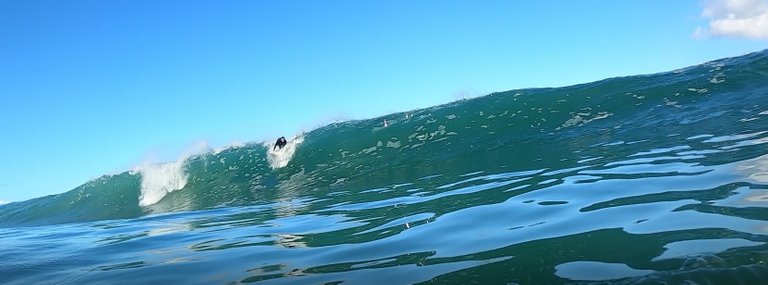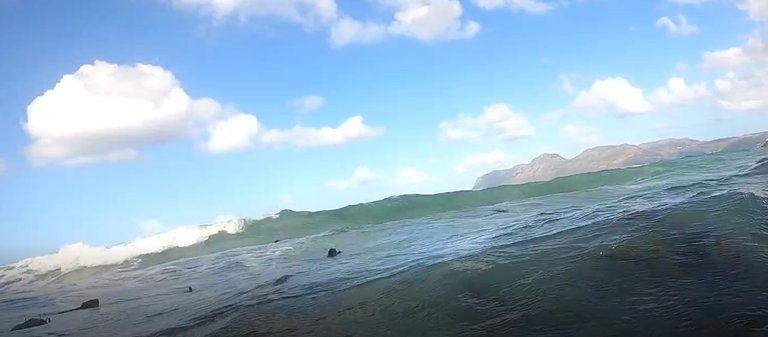SURFING: The "forecast" - why can't I just surf where I want, when I want?

These pictures are taken at the same place on different days – one day was definitely more fun than the other!
Sometimes a friend will come up to me and ask me if I can give them a surfing lesson at Muizenberg beach. I say “sure, let me look and see which day is likely to be the best…” They say, “hold on, I’m only free on Saturday two weeks from now, from 12pm to 2pm…”. I say “that's fine, but don’t expect to have fun! – Who knows what the conditions will be like?” …This always seems to confuse them…
Surfing is not a game of indoor squash – it is very weather dependent!
I have often blabbed on about how Cape Town is the perfect place to live as a surfer. Because it is a peninsula with many nooks and corners, there’s always a place where the wind is blowing in the right direction, and usually a place where the waves are a nice size (exposed spots for a small swell day and sheltered places on a big swell day).

The Cape Peninsula! (Thanks Google Earth)
Not everyone is as lucky to live in a place with such a variety of surf options and may have only one or two similar beaches, facing the same direction, to choose from. Even for those surfers that do live in Cape Town, they may not be able to spare the time or petrol to get from the one side of the Cape peninsula to the other!
So, what do surfers care about when it comes to deciding when (or where) to surf?
SWELL SIZE
This one should seem obvious. You want waves that are big enough to be surfable and fun, but not too big to be scary far beyond your level of ability. In Cape Town there are places where I can hide where the waves from the open ocean must wrap around a corner and can lose a significant amount of size as they do. They usually clean up in the process as well!
SWELL PERIOD
This one is not obvious at all – but swells that come from further away are called “groundswell”. Usually these are clean, powerful and well-spaced for their size and are created by storms far out to sea. The opposite is low-quality “windswell” from a local storm that is usually weak and messy.
SWELL DIRECTION
Another one that is not obvious until you think about it, but some spots will be more exposed to receiving swell from a certain direction, or that swell direction will suit the bottom contour of the reef or beach to make the wave break at the right speed, rather than “close-out” or “fade away”.
BOTTOM CONTOUR
Flatter beaches tend to suit beginners as the waves will stand up (and be catchable) for longer before they break. Beaches and reefs that go from deep to shallow very quickly are more challenging as they break quickly, meaning you have to catch the wave in the perfect place and get to your feet rapidly! The reward is usually more powerful waves for turns and airs, or even hollow waves to try and get barrelled.
For both kinds of waves, the bottom contour should allow the wave to break to the left or right in a diagonal direction so as you leave one section behind, the next section is standing up, getting ready to break, to add new energy to your ride. A “close-out” is the unfortunate event where the wave breaks in front of you and shuts down your ride too soon. The opposite is when the next section runs too deep, and the wave fades away as a result, also ending your ride too soon…
TIDE
Is this an obvious one for non-surfers? A lot of spots, especially reefs, are too deep or shallow for the swell size depending on the tide!
There is a spot at a coastal town, about 90 minutes from Cape Town, where there is a rip current running along the rocks. At high tide, this current takes you as far as you want to go without having to do any work! At low tide, the waves break further out, and you have to paddle the rest of the way while duck-diving through the waves which is significantly more exercise! As a result, the lazy local surfers usually sit around in the parking lot talking nonsense while they wait for high tide!
WIND
The ideal wind for surfing is no wind at all or a soft land breeze (usually in the morning when the land is still colder than the sea). On these days the waves will appear “glassy” like a rolling mirror! Lovely! This is very rare in Cape Town, where there is wind blowing properly from some direction most days.
The next best wind is an “offshore” wind blowing from the land into the sea. This holds the waves up and makes them break cleanly, powerfully and evenly. However, if you paddle for a wave and miss it, you may get punished by the sting of spray from the offshore wind blowing onto your face from the wave breaking towards the beach without you! Offshore days are usually characterized by clean waves, but with this spray blowing off the back.
The worst option is an “onshore” wind blowing from the sea into the land. This tends to break the wave early and make it choppy and weak. However, for good surfers, sometimes it is important to surf days like this. If you can surf well in these conditions, it means you are maximising the energy you get out of using your body as well as the energy you get out of the wave, and you will look amazing in good conditions! Very good surfers who can pull off aerial manoeuvres also claim that an onshore wind helps the board stay on your feel while in the air. For the rest of us mortals, we would rather just stay at home until the wind is offshore again… or if you are in Cape Town, you could simply drive to the other side of the peninsula!
SO, HERE’S A GOOD WAVE

A nice size, and “glassy” because it was unusually calm rather than windy in Cape Town. The slight puff that there was, was in the offshore direction.
AND HERE’S A BAD WAVE

It’s small, sure. Even worse, the wind is onshore making the wave choppy and weak. In addition, the onshore wind has created a kind of secondary wind swell… if you look carefully, the real wave is about to catch up with a smaller wind-swell and will probably fade away or break unpredictably as a result.
SO? WHAT’S THE MORAL OF THE STORY?
If you’re going to be a surfer, be ready to drop everything, even your wedding rehearsal, when the conditions are right... or be prepared to take up kitesurfing as an alternative when the conditions are wrong! Or, come live in Cape Town where it will usually be surfable somewhere on any given day! (Cape Town is actually great for kitesurfing too!)
THE END
Congratulations @jasperdick! You have completed the following achievement on the Hive blockchain and have been rewarded with new badge(s):
Your next target is to reach 200 replies.
You can view your badges on your board and compare yourself to others in the Ranking
If you no longer want to receive notifications, reply to this comment with the word
STOPCheck out the last post from @hivebuzz:
Support the HiveBuzz project. Vote for our proposal!
!1UP
You have received a 1UP from @luizeba!
@sports-curator, @vyb-curator, @pob-curator, @neoxag-curator, @pal-curatorAnd they will bring !PIZZA 🍕
Learn more about our delegation service to earn daily rewards. Join the family on Discord.
Never heard of Boerewors curtain before as most of the people I knew who surfed either were at Muizenberg or Kommetjie.
Haha, in Cape Town people from the Southern Suburbs refer to the Northern Suburbs of Cape Town as "across the Boerewors curtain" due to the higher percentage of Afrikaans speaking people there. For people who are not from South Africa, Afrikaans is a language that started with the early Dutch Settlers in South Africa. The stereotype is that they love a "braai" (barbeque) and that "boerewors" is a kind of sausage that is a staple on a South African braai!
There's plenty of surf spots to the north of the Peninsula for the surfers from these parts to enjoy, but many of them are sensitive to wind. The area is perfect for windsurfing and kite-surfing as a result, and so Cape Town is a dream destination for tourists who enjoy those sports!
So nothing ahs changed lol as we used to always have a dig at the people from the other side meaning Bellville etc or having a CY number plate.
It's all in good fun! Crossing the Boerewors Curtain is best done about now in Autumn, when the winds in Cape Town are unusually calm! Swell is arriving but the skies are often still blue. Nice glassy paradise in about May/June before winter gets too hectic!
You'll notice I labelled the Kommetjie/Scarborough area "crossing the Lentil Curtain" because of all the vegetarian hippies down there! That's where a lot of Cape Town's best big wave spots are!